26/11/2021
Topic:
How to add more 'portable programs' to SyMenu
msillano
|
I'm a new user of SyMenu, and I have a stupid question:
How to add more 'portable programs' to SyMenu (I mind 'portable programas' actually not in SyMenu Suite). ?
My idea is to put it in "xxx\SyMenu\ProgramFiles" , any program in a separate folder.
It 's the correct way? They are some rules to observe?
I looked in Manual, but I don't found anything about this topic.,
Best regards
m.s.
edited by msillano on 26/11/2021 |
26/11/2021
Topic:
How to add more 'portable programs' to SyMenu
msillano
|
Thanks for the fast reply. I will try  |
04/12/2021
Topic:
notes: 'virtual folders' and CSLIDs
msillano
|
A CLSID is a universal unique identifier (UUID) used by Microsoft to identify a COM class object, and the CLSID known by Windows are stored in registry at [HKEY_CLASSES_ROOT\CLSID]. The 128 bit (16 byte) UUID implementation by Microsoft is called also GUID, and the GUID standard form is {4-2-2-2-6} byte HEX.
Using the CLSID you can access special virtual folders or virtual applets. In some cases, CLSID provides access to physical folders on the hard drive or even special operating system features such as "Minimize All Windows" or the Alt + Tab switcher. The CLSIDs give you the control over many Windows operations in fast mode, i.e. creating desktop shortcuts or new items in SyMenu and so bypassing the slow "Control Panel" or all the steps required by 'how-to' instructions.
The SyMenu user has so the power to destructure the native Windows logical organization, and to rebuild new control structures in SyMenu, more functional to their needs and preferences.
howto: test CLSIDs
1) Quick and dirty way to test a CLSID is using the Windows 'Run' dialog: Press Win+R keys on your keyboard, then copy and paste the command, using the CLSID under test:
shell:::{CLSID}
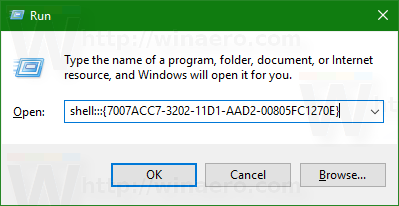
Notes:
- Using the shell, we can also use a 'shell command' as parameter: i.e. a mnemonic replacement (friendly name) defined for some CLSID:
shell:Fonts
- In some cases shell:command works and shell:::{CLSID} not, or viceversa. Better to try both if possible.
2) At the command prompt (in cmd) it is necessary to add 'explorer' or 'explorer.exe' or '%SystemRoot%\explorer.exe', using this:
explorer shell:::{CLSID} or this:
explorer /e, ::{CLSID}

Notes:
- Sometimes the CLSID will only work using one and not the other command above.
3) Windows PowerShell consists of command line shell and scripting language. Also using PowerShell you can use shell commands or CLSIDs. Examples:
Open printers folder:
Start-Process shell:PrintersFolder or:
&{explorer.exe 'shell:::{21ec2020-3aea-1069-a2dd-08002b30309d}\::{2227a280-3aea-1069-a2de-08002b30309d}'}
Open Devices and printers:
&{explorer.exe 'shell:::{A8A91A66-3A7D-4424-8D24-04E180695C7A}'} or even so:
cmd.exe --% /c Explorer shell:::{A8A91A66-3A7D-4424-8D24-04E180695C7A}
More PowerShell examples:
- This list all Special Folders names:
[Environment+SpecialFolder]::GetNames([Environment+SpecialFolder])

- This last example returns the real path of Desktop:
[Environment]::GetFolderPath([Environment+SpecialFolder]: esktop) esktop)
howto: use CLSIDs in shortcuts
Making a shortcut to a special folder allows us to have a quick link from the desktop or from anywhere, to the required
feature of Windows.
4) Create a new shortcut (on your desktop or wherever you like) in the usual way, but use for "Type the position of the Item":
explorer.exe shell:::{CLSID}
Add a meaningful name and create it. Re-edit the shortcut properties to change the icon however you like.
5) A different way to get same result: goto where you wont to create a shorcut, but create instead a directory, and give it the a name with the CLSID of the target as extension:
yourFolderDisplayName.{CLSID}
Note:
- with god mode (all Tasks) the displayName becomes empty. Known issue.
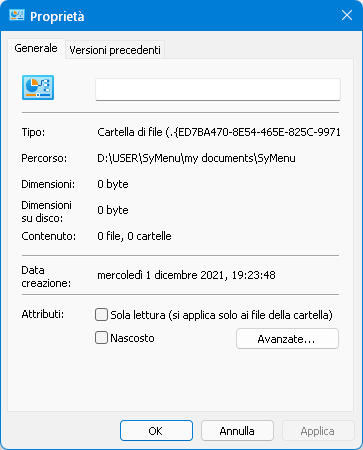
6) You can also use a file BAT as shortcut, the content can be:
:: Sample Batch Script to open the Action Center via CLSID shell
@echo off
%SystemRoot%\explorer shell:::{BB64F8A7-BEE7-4E1A-AB8D-7D8273F7FDB6}
exit
Of course, you can use CLSIDs in any BAT file, to implement automation tasks involving Windows.
Note:
- Also in BAT you have 3 alternatives, try them all:
explorer shell:command
explorer shell:::{CLSID}
explorer /e, ::{CLSID}
7) If you are really lazy, you can use a nice, well documented program: Winaero Tweaker to build your own shortcuts. It allows you to test CLSID commands and to create Shortcut with just 2 clicks.
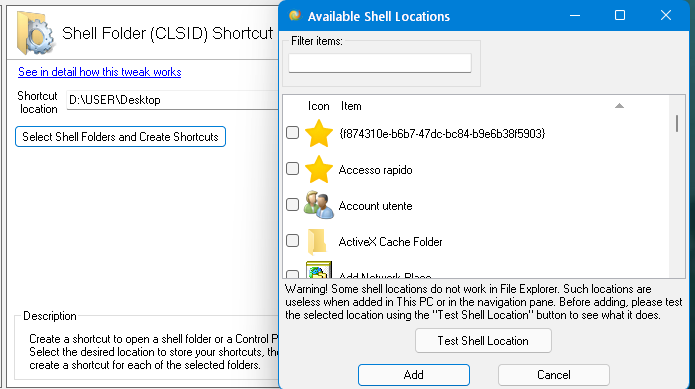
howto: use CLSIDs with SyMenu
8) If the CLSID points to a Directory, we can use 'Add link to folder' in configuration, and:
- show the directory content as cascading submenus
- swow it in a new file explorer window (option 'Show as Link' = yes).
Note:
- You can use here all the 'virtual folder' parametric path from the program 'Special FolderView' (in NirSoft suite). Example:

- This example is extracted from SyMenuItem.xml to avoid typos. The '<guid>' you see is used as a unique record key in the sqlite DB, used internally by SyMenu, nothing to do with Microsoft GUIDs.
9) Using 'Add Program' in configuration you get a new window. The Path is always the same:
%SystemRoot%\explorer.exe
As parameter you can use:
- directly a directory (parametric, real or virtual)
- or one of the usual alternatives, one that works:
shell:command
shell:::{CLSID}
/e, ::{CLSID}
Examples:
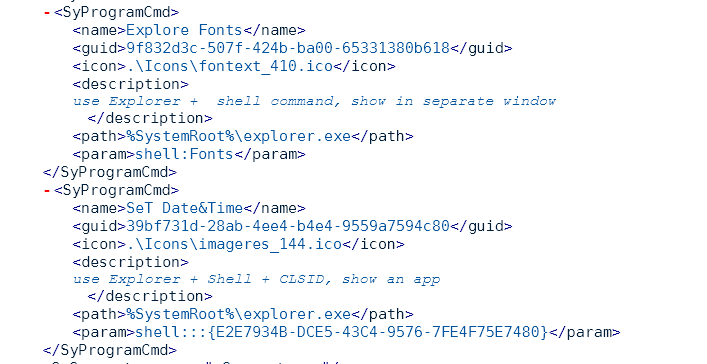
howto: a more complex example
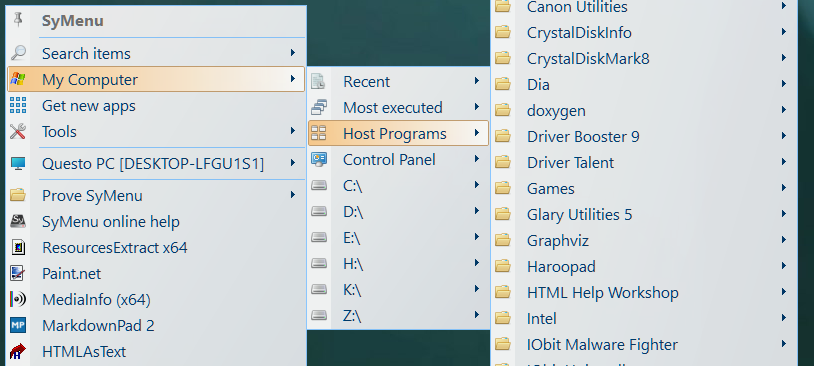
The standard option 'My Computer' in SyMenu presents me some problems:
. - 'Host programs', in WIN11, don't found the Microsoft 'apps' (Photos, Calculator etc.)
- 'Host programs' submenu is too long.
- 'Contol panel' can be replaced by 'God mode'
- The menu shows some removables drives (H:, K:) even if the drives are not in place.
- The full HD navigation via submenu to found executables is time consuming and too big on desktop.
- The SyMenu Link implementation finds only some fixed file type, miss empty dirs, and always forces you to traverse all the paths until a final file. It cannot be stopped at an intermediate dir (eg. Clicking on a dir in a submenu, to open an instance of file explorer on that dir).
I don't care: what I like about SyMenu is the flexibility! With CLSIDs I can create my own implementation of "This PC" to suit my needs and replace the standard "My Computer".

- Explore recents link opens the dir %APPDATA%\Microsoft\Windows\Recent. Any kind of files, so Link=true.
- Programs uses the CLSID {4234d49b-0245-4df3-b780-3893943456e1} (Applications).
This is the unique way I found in WIN11 to access installed applications (Start menu) AND Microsoft apps (like StickyNotes, Calculator, etc.).
- God mode uses the CLSID {ED7BA470-8E54-465E-825C-99712043E01C} (all tasks)
- C: D: Z: they are links (links = true) that do not point to the root of the disks, but directly to the folders of interest.
- PROJECTS presents some useful items for quick access.
- Since I am now installing my new PC, the last 4 items are related to program management. WinUnistall uses the CLSID {7b81be6a-ce2b-4676-a29e-eb907a5126c5}
References
- For a general start point I found interesting this article
- For more information about the CLSID key and the function of it's subkeys in the registry, see Microsoft 'CLSID Key (COM)'
- For Windows 11 CLSIDs and 'shell commands' click here
- For Windows 10 CLSIDs and 'shell commands' click here
- All CLSIDs on your computer can be fund using ShellExView program (NirSoft suite)
- All special folders on your computer can be fund using SpecialFolderView program (NirSoft suite)
- For your convenience a list of CLSIDs (WIN10) is added as atthach. Format as OpenOffice spreadsheet, so you can edit it.
edited by msillano on 04/12/2021
edited by msillano on 04/12/2021
edited by msillano on 05/12/2021 |
16/01/2022
Topic:
PrettyPrint SyMenu: a new tool for SyMenu
msillano
|
prettyPrint SyMenu (prettyPrintItems.bat) is a tool that extracts a snapshot from the file SyMenuItem.zip, with all the data of the nodes currently existing in the SyMenu menu and presents it, in the form of a complete tree, in a dynamic HTML page. This allows you to easily manage menus of any size and complexity.
The prettyPrint SyMenu output document itself is a useful documentation, but you can also cut a branch and insert it in any of your pages: HTML, markdown (not GitHub flavor), Doxygen, etc.. maintaining colors and dynamicity.
Download:
Installation:
- Unzip the distribution file in [SyMenu]/Programfile
- Add to SyMenu 'prettyPrintItems.bat'
- Done
------------------
My SyMenu tools project (ms_symtool) was born with to provide SyMenu with a serie of advanced features, to facilitate the maintenance of complex menus. Of course portables.
Best regards.
m.s.
edited by msillano on 17/01/2022 |
15/02/2022
Topic:
SyMenu MDExchange: to export/import/share menus
msillano
|
SyMenu MD Exchange (https://github.com/msillano/ms_symtools/tree/main/MDexchange) allows you to document and 'share' partial or full SyMenu trees with other users. The Markdown format enables for easily management of large menus: by editing comfortably an MD file, in a featured editor, you can update and reorganize the menu tree, change names and edit tooltips for all items.
SyMenu MD Exchange consist of two tools to export and import SyMenu structure to/from markdown files: SyMenu2MDexport.bat and MD2SyMenuimport.bat , plus the extra SyMenuUndo.bat, to revert the SyMenu changes.
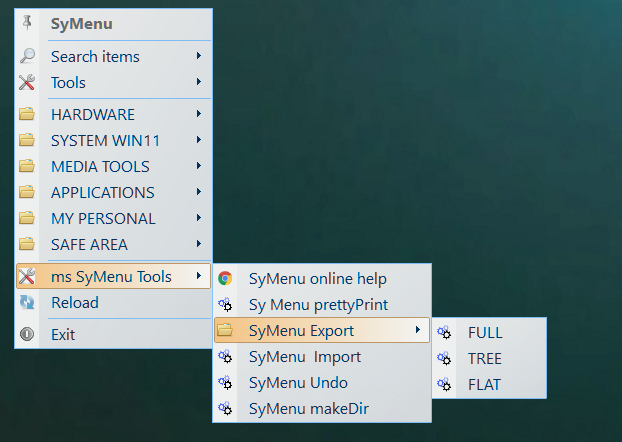
Perhaps the best use of this tool is the creation of large classification tree, in the case of reorganizations of your SyMenu. (e.g. creation of a SyMenu specialozed in Multimedia).
Download:
Installation:
- Unzip the distribution file in [SyMenu]/Programfile
- Add to SyMenu SyMenu2MDexport.bat for export, MD2SyMenuImport.bat for import, SyMenuUndo.bat for undo. Optional: see in figure my solution.
- Done
------------------
My SyMenu tools project (ms_symtool) was born with to provide SyMenu with a serie of advanced features, to facilitate the maintenance of complex menus. Of course portables.
edited by msillano on 15/02/2022
edited by msillano on 15/02/2022 |
15/02/2022
Topic:
Windows and me: a 'shared' menu
msillano
|
This menu for SyMenu, named 'Windows and Me', is my first attempt to define and share a generalist menu for advanced users. Any comments and contributions are welcome.

For more info and use instructions see the attached file Windows_and_Me.1.0_en.SyMenu.pdf.
Best regards
m. sillano |
19/02/2022
Topic:
SyMenu to dir: done the last ms_symtool (for now).
msillano
|
'SyMenu to dir' tool solves a small problem:
building a directory tree with the same structure as the current SyMenu menu, and keep it updated.
I use these directories to neatly store some documents and links (e.g. to Windows apps) related to SyMenu.
Because I'm lazy, I've build a tool to do this task  . .
As usual it is open source: for more info see the Github project and the help file.
Download:
Installation:
- Unzip the distribution file in [SyMenu]/Programfile
- Add to SyMenu SyMenu2dir.bat
- Done
Best regards
m.s.
edited by msillano on 19/02/2022 |